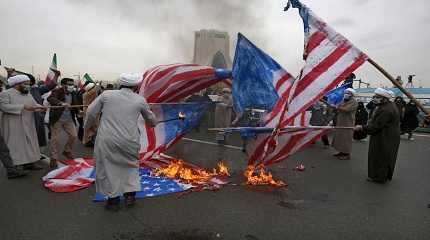
TEHRAN, Iran (AP) — Thousands of cars and motorbikes paraded in celebration of the 43rd anniversary of Iran’s 1979 Islamic Revolution on Friday, although fewer pedestrians were out for a second straight year due to concerns over the coronavirus pandemic.
In the capital Tehran, processions started out from several points, converging on the usual meetup point at Azadi Square. State media said hundreds of thousands of people were involved in the celebrations, and state TV showed crowds in many cities and towns.
The anniversary comes as negotiations to revive Tehran’s tattered nuclear deal with world powers continue in Vienna. Former President Donald Trump withdrew the United States from the deal in 2018 and re-imposed sanctions, and in response Iran gradually reneged on its commitments.
President Ebrahim Raisi said Iran was seeking a balanced foreign policy, but would take “big steps” to further economic independence. “We never pinned hopes to Vienna and New York,” he said in a speech before Friday prayers in northern Tehran’s Mosalla Mosque.
White House press secretary Jen Psaki said on Wednesday that a deal is “in sight,” but warned that “if it’s not reached in the coming weeks Iran’s nuclear advances will make it impossible” for the U.S. to return to the deal.
Crowds waved Iranian flags, chanting slogans and carrying placards that read “Death to America” and “Death to Israel” in celebration on Friday, a commemoration for the uprising that ousted a Western-backed monarchy and brought the Islamists to power. Several groups in Tehran and elsewhere burned U.S. and Israeli flags, a regular ritual at Iranian rallies.
It was the second year where celebrations were largely limited to vehicles due to the pandemic. Authorities say the aggressive omicron variant is now dominant in the country, and hospitals have been urged to prepare for a new wave of infections.
With more than 130,000 total deaths according to official numbers, Iran has the highest national death toll in the Middle East. It says it has vaccinated some 80% of its population above age 18 with two shots, although only 27% of that group has had a third shot.
Iran’s Islamic Revolution began with widespread unrest over the rule of Shah Mohammad Reza Pahlavi. The shah, terminally and secretly ill with cancer, fled Iran in January 1979. Ayatollah Ruhollah Khomeini then returned from exile and the government fell on Feb. 11, 1979, after days of mass demonstrations and confrontations between protesters and security forces.
In April 1979, Iranians voted to become an Islamic Republic, a Shiite theocracy with Khomeini as the country’s first supreme leader, with final say on all matters of state.
When the U.S. later allowed the shah into the United States for cancer treatment in New York, anger boiled over in Tehran leading to the takeover of the U.S. Embassy in November 1979 by militant students. The subsequent hostage crisis kindled decades of enmity.




